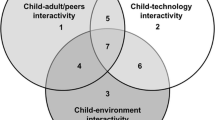Abstract
This naturalistic, qualitative study examines the nature of child- and adult-led interactions in a children’s museum. Using dialogic learning as a theoretical framework, the study examines how children and adults engage in interactions while learning at a museum. Findings suggest that children and adults are almost equally likely to lead interactions; however, most child-led interactions are qualitatively different from adult-led interactions. Children are more likely to show-and-tell about their experiences and learn by asking questions and commenting about their play. Adults are more likely to teach by telling, prompting, and reporting a child’s activities. Children and adults also are equally engage in pretend play during their interactions. Leveraging these findings, recommendations are made for museum exhibit space design.


Similar content being viewed by others
References
Association of Children’s Museums. (2013). The case for children’s museums. Available online at http://www.childrensmuseums.org/index.php/home.html.
Bus, A. G., Leseman, P. P., & Keulties, P. (2000). Joint book reading across cultures: A comparison of Surinames-Dutch, Turkish-Dutch, and Dutch parent–child dyads. Journal of Literacy Research, 32, 53–76.
Christie, J., & Johnsen, E. P. (1983). The role of play in social-intellectual development. Review of Educational Research, 53, 93–115.
Danis, A., Bernard, J., & Leproux, C. (2000). Shared picture-book reading: A sequential analysis of adult–child verbal interactions. Developmental Psychology, 18(3), 369–388.
Denzin, N. K., & Lincoln, Y. S. (1984). Handbook of qualitative research. Newbury Park, CA: Sage.
Dockett, S., Main, S., & Kelly, L. (2011). Consulting young children: Experiences from a museum. Visitor Studies, 14(1), 13–33.
Eckhoff, A. (2008). The importance of art viewing experiences in early childhood visual arts: The exploration of a master art teacher’s strategies for meaningful early arts experiences. Early Childhood Education Journal, 35, 463–472. doi:10.1007/s10643-007-0216-1.
Harry, B., Sturges, K. M., & Klinger, J. K. (2005). Mapping the process: An examplar of process and challenge in grounded theory analysis. Educational Researcher, 34(2), 3–13.
Henderson, T. Z., & Atencio, D. J. (2007). Integration of play, learning, and experiences: What museums afford young visitors. Early Childhood Education Journal, 35, 245–251. doi:10.1007/s10643-007-0208-1.
Korat, O. (2010). How new technology influences parent–child interaction: The case of e-book reading. First Language, 30(2), 139–154. doi:10.1177/0142723709359242.
Laakso, M. L., Poikkeus, A. M., Eklund, K., & Lyytinen, P. (2004). Interest in early shared reading: Its relation to later language and letter knowledge in children with and without risk for reading difficulties. First Language, 24, 323–345.
Landsdown, G. (2005). Can you hear me? The right of young children to participate in decisions affecting them. Working paper 36. The Hague: Bernard van Leer Foundation.
Lillard, A. S., Lerner, M. D., Hopkins, E. J., Dore, R. A., Smith, E. D., & Palmquist, C. M. (2012). The impact of pretend play on children’s development: A review of the evidence. Psychological Bulletin, 139(1), 1–34. doi:10.1037/a0029321.
Luke, J. J., & McCreedy, D. (2012). Breaking down barriers: Museum as broker of home/school collaboration. Visitor Studies, 15(1), 98–113.
Mayfield, M. I. (2005). Children’s museums: Purposes, practices and play? Early Child Development & Care, 175(2), 179–192. doi:10.1080/0300443042000230348.
Palmquist, S., & Crowley, K. (2007). From teachers to testers: How parents talk to novice and expert children in a natural history museum. Science Education, 91(5), 783–804. doi:10.1002/sce.20215.
Payley, V. G. (2005). A child’s work. Chicago, IL: University of Chicago Press.
Phillips, B. M., & Lonigan, C. J. (2005). Social correlates of emergent literacy. In M. J. Snowling & C. Hulme (Eds.), The science of reading: A handbook (pp. 173–187). Oxford, England: Blackwell.
Roskos, K. A., & Christie, J. F. (2011). Mindbrain and play-literacy connections. Journal of Early Childhood Literacy, 11, 73–94. doi:10.1177/1468798410390889.
Sanford, C. W. (2010). Let’s give ‘em something to talk about: How participation in a shared museum experience can seed family learning conversations at home. Dissertation Abstracts International, 71(3-A), 911. (University of Pittsburgh).
Sénéchal, M. (1997). The differential effect of storybook reading on preschoolers’ acquisition of expressive and receptive vocabulary. Journal of Child Language, 24, 123–138.
Shine, S., & Acosta, T. Y. (2000). Parent–child social play in a children’s museum. Family Relations, 49(1), 45–52.
Strauss, A. L., & Corbin, J. (1998). Basics of qualitative research: Grounded theory procedures and techniques. Newbury Park, CA: Sage.
Styles, C. (2011). Dialogic learning in museum space. Ethos, 19(3), 12–20.
U.S. National Research Council of the National Academies. (2001). Early childhood development and learning: New knowledge for policy. Washington, DC: National Academy Press.
Wood, E., & Wolf, B. (2008). Between the lines of engagement in museums. Journal of Museum Education, 33(2), 121–130.
Author information
Authors and Affiliations
Corresponding author
Rights and permissions
About this article
Cite this article
Dooley, C.M., Welch, M.M. Nature of Interactions Among Young Children and Adult Caregivers in a Children’s Museum. Early Childhood Educ J 42, 125–132 (2014). https://doi.org/10.1007/s10643-013-0601-x
Published:
Issue Date:
DOI: https://doi.org/10.1007/s10643-013-0601-x




